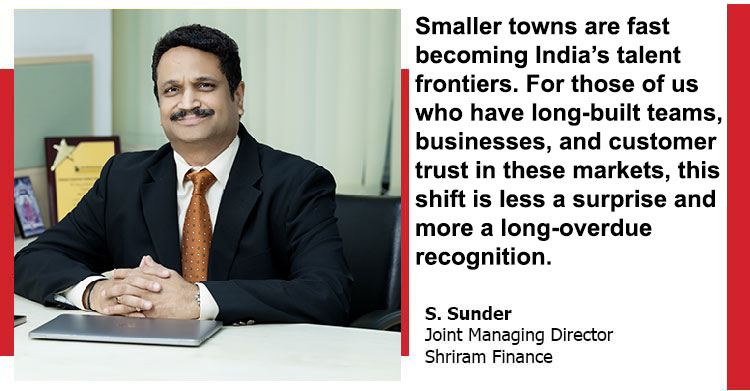Beyond the Metros: Hiring in Tier-3 and Tier-4 India | S.Sunder | Joint Managing Director | Shriram Finance Ltd

Smaller towns are fast becoming India’s talent frontiers. For those of us who have long-built teams, businesses, and customer trust in these markets, this shift is less a surprise and more a long-overdue recognition. Leaders must now reimagine hiring strategies to align with the same ground realities that have always powered Bharat’s economic story.
India’s workforce is no longer clustered around metro cities. Job openings in Tier 2 and Tier 3 cities have climbed sharply, recent reports show, with some regions seeing increases of over 50% far outpacing metro growth. IT hiring, in particular, is booming in non-metro locations, often growing more than three times faster than in major cities. Cities like Nashik, Visakhapatnam, Vadodara, and Jodhpur now rank among the country’s fastest-emerging hubs for new talent.
Yet, the promise of smaller-town talent is tempered by practical challenges: skills mismatches, patchy infrastructure, limited access to advanced training, and inconsistent exposure to professional networks. Recognizing both sides—the potential and the limitations—is crucial for effective hiring. For instance, a young graduate in a Tier-3 city may have strong academic credentials but limited experience with professional tools or sector-specific practices, requiring targeted upskilling.
What’s Fueling the Shift
Understanding what’s driving this outward movement of hiring helps align recruitment strategy better:
1. Digital & Infrastructure Enablement
Improving internet penetration, remote work tools, and digital services have empowered smaller-town professionals to showcase their capabilities on par with urban peers. With digital adoption and flexible work models are widening access, making geography less limiting.
2. Policy & Economic Incentives
Government initiatives, investment in regional connectivity, and rising MSME activity are creating more opportunities locally. According to LinkedIn’s Cities on the Rise 2025 report cities such as Nashik, Visakhapatnam, Vadodara, and Jodhpur are among India’s 10 fastest-growing emerging hubs for talent. These emerging corridors are becoming the country’s next engines of employment growth, driven by affordability, infrastructure upgrades, and expanding corporate footprints
3. Employer Demand for Local Talent
Businesses aim to reduce attrition, optimize costs, and leverage untapped talent ecosystems. Interest from smaller-town professionals is evident, but enthusiasm does not guarantee fitment. Digital literacy, sector-specific expertise, and soft skills gaps remain significant, making local training and mentorship essential. Organizations that invest in structured onboarding and continuous learning often see higher retention and stronger community engagement.
What Professionals in Tier 3/4 Truly Seek
In hiring from these regions, it’s essential to align with what motivates people, often in ways more nuanced than in metros:
Belonging & Cultural Resonance: Many professionals want meaningful connection with their local place of origin—opportunities that do not force dislocation, but instead allow them to grow while being rooted.
Clarity of Growth: Security matters. But equally, clear, transparent career paths—where individuals can see where they will be in, say, 3-5 years—matter more than flashy titles.
Access to Learning & Technology: Equal access to upskilling, digital learning, exposure to new tools is non-negotiable. Professionals expect it even if their location is remote.
Strategy for Hiring Aligned with Aspirations
How can organizations adapt to this changing talent map?
Localized Employer Value Proposition: Position the workplace not just as an institutional employer, but as part of regional growth—both economic and social. Messaging, branding, and culture must reflect that.
Transparent & Structured Career Paths: Lay out progression clearly. Show potential journeys junior → mid → senior—so people can map their professional growth.
Identifying & Elevating Local Leaders: Promote people from smaller towns into leadership roles; visible role model’s matter. When someone from a similar background rise, it changes perceptions and inspires others.
The psychology of hiring here is not transactional. It is relational — grounded in belonging, trust, and visible progress. Leaders who have built organizations in these markets know that when you invest in a professional’s growth in their hometown, you don’t just gain an employee. You gain a long-term partner in building a sustainable business ecosystem.
Why the Shift Matters
This isn’t just a passing trend it’s a strategic imperative. Embracing hiring from Tier 3/4 geographies brings:
Cultural Relevance: Team members from smaller cities get the pulse of local customers—their language, habits, and aspirations. That’s pure gold for industries like finance, retail, and services.
Optimized workforce investments: You’ll also notice fewer overheads—smaller towns usually mean lower costs, and remote work keeps things lean.
Competitive Differentiation & Diversity: Inclusion of talent from diverse geographies strengthens innovation, helps organizations stay relevant across India’s varied markets.
Looking Forward: Aligning with India’s Future
India’s workforce is young, increasingly educated, and tech-enabled. The metro-centric model of attracting talent with high pay and brand prestige alone will not suffice. In smaller towns, opportunity must be contextual, anchored in stability, growth, belonging, and respect.
Organizations that succeed will be those that embed themselves in local aspirations, address skills and infrastructure gaps, and cultivate trust within communities. This involves sustained engagement—supporting local education initiatives, creating mentorship pipelines, and ensuring technology access keeps pace with ambition.
The next chapter of India’s workforce story will be written where ambition meets community—and where loyalty evolves into long-term partnerships. In Tier-3 and Tier-4 India, hiring is not just filling positions; it is building ecosystems, nurturing talent, and shaping the future of work. Firms already investing in hometown talent are seeing big rewards. If you haven’t started, now’s the moment to get on board.


